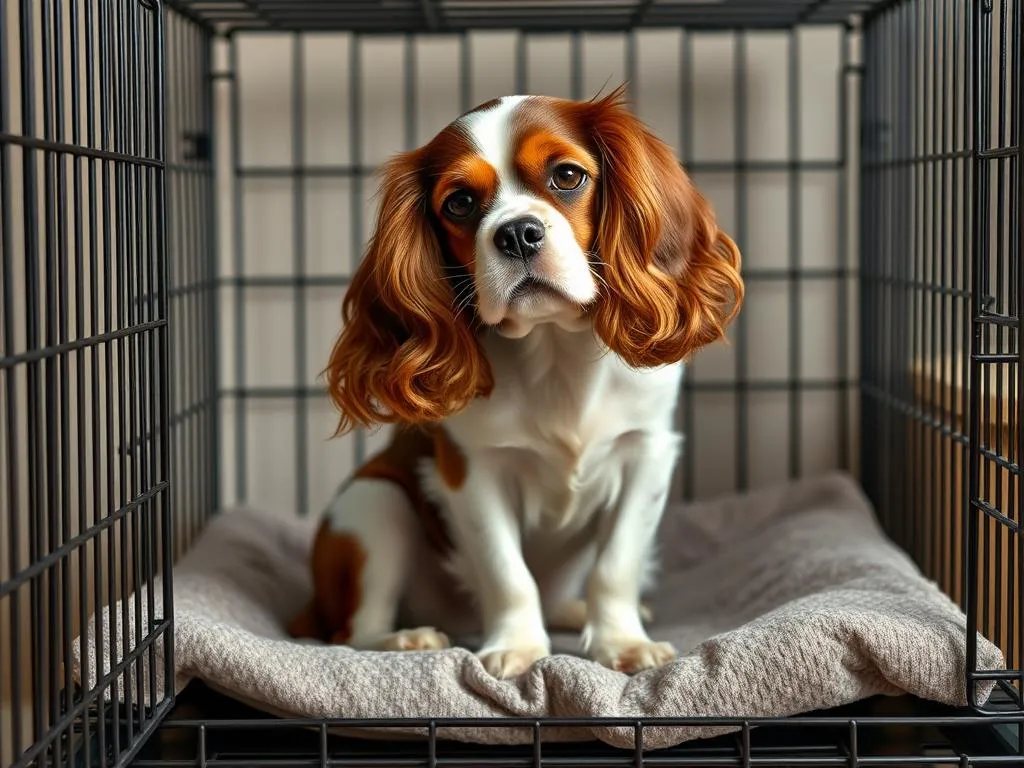
Introduction
Crate training plays a crucial role in the lives of many dog owners and their furry companions. For Cavalier King Charles Spaniels (CKCS), a breed known for its affectionate nature and playful demeanor, proper crate training can provide a sense of security and comfort. This comprehensive guide aims to help you understand the steps involved in effectively crate training your CKCS, highlighting the benefits such as housebreaking, travel safety, and managing separation anxiety.
Understanding the Cavalier King Charles Spaniel
Breed Characteristics
Cavalier King Charles Spaniels are a charming breed known for their friendly temperament and sociable nature. They are affectionate, eager to please, and generally get along well with both people and other pets. CKCS are also playful and have moderate energy levels, making them perfect companions for families and individuals alike. Understanding these traits is essential when crate training, as it helps you tailor the process to suit their unique personality.
Why Crate Training is Important for CKCS
Crate training serves multiple purposes for CKCS. Firstly, it provides a safe haven for this small breed, protecting them from potential hazards around the house. Secondly, many CKCS can experience separation anxiety, and a crate can create a secure environment for them when left alone. Lastly, establishing a routine through crate training helps these dogs feel comfortable and secure, which is crucial for their overall well-being.
Preparing for Crate Training
Choosing the Right Crate
Selecting the appropriate crate is the first step in the crate training process. For a Cavalier King Charles Spaniel, a crate that is too large can lead to confusion about where to sleep and where to eliminate. Ideally, choose a crate that allows your CKCS to stand up, turn around, and lie down comfortably. Look for a crate with good ventilation and accessibility features, such as a removable tray for easy cleaning.
Setting Up the Crate
The location of the crate in your home is vital. It should be placed in a quiet, comfortable area where the dog feels secure but can still see family activity. Making the crate inviting is essential; add comfortable bedding, a favorite toy, or a blanket to create a cozy atmosphere. You want your CKCS to view the crate as a positive and safe space.
Gathering Training Supplies
Before starting the crate training process, gather necessary supplies. Treats are essential for positive reinforcement, and a clicker can help in marking desired behaviors. Additionally, consider safety items such as a water bowl that attaches to the crate and a crate cover to provide a sense of privacy and security.
The Crate Training Process
Introducing the Crate
To begin crate training, introduce your CKCS to the crate gradually. Use positive reinforcement to encourage exploration. Place treats and toys inside the crate to entice your dog to enter. Praise your CKCS when they show interest in the crate, helping them build a positive association.
Gradual Crate Training Steps
Short Periods of Confinement
Start by confining your CKCS to the crate for short periods, around 5-10 minutes. This initial step allows them to acclimatize without feeling overwhelmed. Gradually increase the duration as your dog becomes more comfortable.
Gradually Increasing Time in the Crate
Once your CKCS is comfortable with short periods, gradually increase the time they spend in the crate. By doing this, you help them understand that the crate is a safe space and not a punishment.
Leaving the Room Temporarily
Begin leaving the room for short intervals while your CKCS is in the crate. This step reinforces the idea that being in the crate is not only safe but also allows for moments of separation that are temporary.
Developing a Routine
Establishing a consistent schedule for crate time is crucial. Incorporate crate time into daily routines, such as feeding, walks, and playtime. Consistency is key; it helps your CKCS understand when to expect crate time and reinforces their sense of security.
Addressing Common Challenges
Dealing with Resistance
Some CKCS may initially resist entering the crate. Signs of anxiety may include whining, barking, or refusal to enter. If you notice these signs, slow down the integration process. Build trust by allowing your CKCS to explore the crate at their own pace and offering plenty of positive reinforcement.
Handling Barking and Whining
Vocalization can be common during crate training. Understanding the reasons behind barking or whining is essential. Often, CKCS may vocalize due to boredom or anxiety. Techniques such as ignoring the vocalization or providing distractions (like a chew toy) can help manage this behavior.
Avoiding Negative Associations
One critical aspect of crate training is to ensure that the crate is never used as a form of punishment. Instead, focus on creating positive experiences associated with the crate. Regularly reward your CKCS for entering the crate willingly and for being calm while inside.
Advanced Crate Training Techniques
Crate Training for Travel
Preparing your CKCS for travel in a crate is essential, especially if you plan road trips or flights. Start acclimating your dog to the crate in a stationary position before introducing it in a moving vehicle. Ensure that the crate is secure and well-ventilated, and consider taking familiar items along to provide comfort.
Crate Training for Housebreaking
Using the crate as a tool for potty training is highly effective. Dogs naturally avoid soiling their sleeping area, making the crate an ideal space for housebreaking. Establish a routine where your CKCS is taken outside immediately after being let out of the crate. Watch for cues that they need to go, such as sniffing or circling, and be sure to reward them for doing their business outside.
Crate Training for Separation Anxiety
Cavalier King Charles Spaniels can be prone to separation anxiety. Identifying signs such as excessive barking, destructive behavior, or loss of appetite can help you address the issue. Gradual departures can ease anxiety; practice leaving your CKCS in the crate for short periods while you go to another room. Comfort items, like a favorite blanket or toy, can also help soothe their nerves.
Maintaining Crate Training
Regular Crate Use
Incorporating regular crate use into your CKCS’s daily life has numerous benefits. It can provide a safe space for your dog during family activities, help with housebreaking, and manage anxiety. The more your dog is accustomed to their crate, the more comfortable they will become with it.
Monitoring Your CKCS’s Progress
As you continue crate training, pay attention to your CKCS’s comfort levels. If they seem anxious or restless, it may be time to adjust your training strategies. Regularly assess their behavior and adapt your approach to suit their needs.
Conclusion
Crate training a Cavalier King Charles Spaniel can be a rewarding experience for both you and your furry friend. By understanding their unique temperament and implementing a structured training plan, you can create a secure and comfortable environment for your CKCS. Remember to be patient and consistent throughout the process; successful crate training leads to a happier, healthier dog and a more harmonious home. Embracing crate training not only benefits your CKCS but also enhances your bond with them, ensuring a loving and trusting relationship for years to come.









